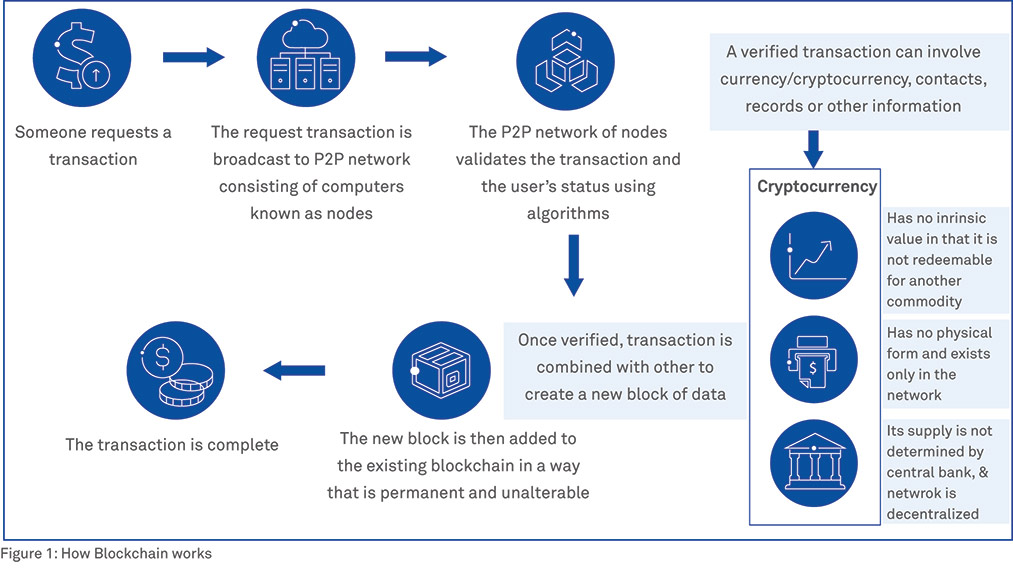Blockchain technology is getting tremendous traction in the world. We want to look at the use of this tech in the telecom industry – the probable areas of use, what the leaders are doing and where Wipro can help it’s clients deploy in the future.
What is Blockchain?
We all associate Blockchain with Bitcoins. To be fair, that’s how it started – Bitcoins were/ are transferred through blockchain before other use cases were imagined and developed. And now this technology is fast evolving to disrupt the way transactions are being processed, users are being authenticated and payments are being executed. Fintech was one of the earliest industries to first adopt the technology. However, there are varied possibilities in almost every industry. In this document, we will see the implications and opportunities that are available in the telecom industry.
Blockchain is a shared ledger that is replicated across users in a particular network. The ledger maintains all the transaction details between parties. The entire system becomes highly secure, transparent and devoid of any restricting intermediary that we all depend on in any similar transaction-based network available. If a customer requests for a transaction (let’s say order bread from Amazon), this transaction will be transmitted in the Blockchain network through its own unique #. One of the nodes will identify the # and verify it and enable the transaction to be completed.
At no given point in time does the node get to know who the final end customer or vendor is. Hence, Blockchain is an incorruptible digital diary comprising of transactions (can be data, currency or anything of economic value). Each transaction is unique and gets recorded in a distributed system that can never be lost.
Telecom organizations in 2019 – How are things shaping up?
Interestingly, the way the telephone connects people hasn’t changed dramatically over the last 20 years. Yes, our SIM cards have grown smaller and we now have many ways to transmit audio, video and text over the internet, but the core telephone logic based on the SIM cards (which were developed way back in 1991) has not changed. What has completely changed is the way we treat data. The speed of transfer over the internet cannot be compared to three or maybe four years back. 5G, which is being tested currently, will allow ever higher data transfer rates, minimum network latency and a huge system of interconnect devices. We will see application of using IOT devices, sensors, facial recognition, AR, VR to achieve a variety of use cases previously unimagined.
Both providers and subscribers struggle with roaming, high fees, risk of fraud, privacy issues and so much more. After exploring potential solutions, decentralization (which is one of the core fundamentals of Blockchain) could be the key to solving those issues.

Pain points in the industry and how can Blockchain act as a solution to these problems
Organizations are looking for new innovative ways to reduce underlying costs and improve business profitability. We look at a few modern pain points of the telecom industry and why should they look at Blockchain as a tech intervention to solve for the future:
How can Blockchain help these situations
Use cases in telecom
With the multiple pain points coming, we also have emerging technologies like Blockchain that helps CSPs to work and keep themselves profitable and relevant in the market. In this section we will try and correlate the use case as per the pain points mentioned in the section above:
The above use cases are an indication of the areas where Blockchain can play a part in organizations. However, the border of this playground is yet to be defined as we move ahead in this technology’s implementation. The following section looks at some of the existing implementations that some of the leading telcos have deployed so far.
How are the existing telecom organizations using Blockchain?
Our verdict and what can be achieved further? Needless to say, Blockchain is here to stay and we can see the rapid adoption and deployment of this tech by the various leading telecom organizations. And in this journey, organizations such as ours can play a significant role in helping our clients moving into the future.
Wipro has built a Blockchain solution for Order Management and fulfillment process that provides end-to-end visibility and unparalleled data validation for order management with touchless invoice generation for participants in the SCM value chain.
It also integrates with IoT sensors to track tempering, temperature, shock and GPS-based route planning for moving assets. Few key features that compliments this offering are as follows:
We are looking at a future where we reduce dependency on traditional centralized software/ operators to provide an authentication mechanism. Imagine a situation where there isn’t a requirement for expensive CRM/BRM software and organizations are able to track all transactions over Blockchain using identification #s. Imagine a scenario where end customers are able to trade their extra bandwidth of data within themselves. Blockchain can make all this possible.
References
1. https://www2.deloitte.com/content/dam/Deloitte/%20za/Documents/technology-media-%20telecommunications/%20za_TMT_Blockchain_TelCo.pdf
2. https://www.sdxcentral.com/articles/news/telefonica-ibm-collaborate-on-telecom-block-chain/2018/11/#targetText=IBM%20and%20Telef%Cness%20and%20network%20processes.
4. https://www.forbes.com/sites/benjaminpirus/%202019/08/20/vodafone-with-%20ibm-for-trustsupplier-%20blockchain/#7077f4457de0
5. https://www.forbes.com/sites/benjaminpirus/2019/06/13/how-telecom-mobile-are-using-blockchain/#21c9d2486db0
Abhinav Dutta
Senior Manager, Enterprise Operations Transformation, Wipro Limited
Abhinav has over eleven years’ experience across diverse roles spanning research, consulting, presales, solution and relationship management for industry domains such as telecom, media, energy, utilities and banking. He helps organizations define and refine their vision of technology transformation in a digitally disruptive business environment.